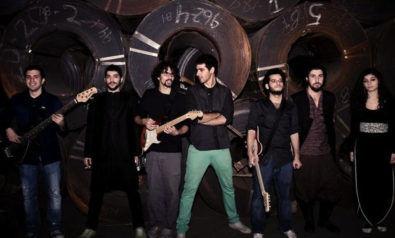I am sitting in a bar located in a typical neighborhood of Lisbon. Hitherto, the atmosphere is full of dilated laughter. All around a distracted bonhomie is being served with good wine. Then, in a somehow careful but not so elegant gesture, a middle-aged man stands up. Wearing a heavy face, he sweeps the whole room with his bulging eyes hoping that everyone will realize something is going to happen. No stage, no lights, no special effects. Two other men, holding cittern-shaped guitars sit down behind him. Someone says, “silêncio que se vai cantar o Fado!” (Silence, Fado will be sung!). The audience obeys and a striking silence floods the room. Eyebrows furrow to solemnity and a mournful tune starts to be played by the guitarists. The singer´s voice is rough, but it stretches, retracts, breathes. The words describe a missing love, fate and their massive weight on a man´s soul. Next to me, a tourist whispers, “so… this is Fado, huh?”
The myriad of travel guides will tell you, yes, that is Fado and yes, it is a Portuguese music genre. The newer ones will even tell you it is now part of UNESCO’s cultural heritage. In fact, there are two distinct styles of Fado. The Fado associated with the city of Lisbon and the Fado that arose in the north central Portuguese city of Coimbra.
Lisbon’s Fado is characterized by taciturn, melancholic tunes. Its elegiac lyrics are often related to something absent, distant or lost, constituting a peculiar celebration of the feeling of loss itself. This is why Fado has a close relationship with the Portuguese word saudade. There is a wide debate about the possibility of translating this word into other languages. “Longing for something” in English and “Sehnsucht” in German are a few examples of translations one will find in Western languages. However, they are somehow distant from the true meaning. There is actually a myth, which has its roots in nationalist movements led by intellectuals in the beginning of the 20th century, that claims it is impossible to translate the word because it is something solely understood by the Portuguese. The majority of Portuguese do believe in this myth.
It would be strange for such a common feeling to not have its linguistic counterpart in other cultures, though, and indeed to a certain extent every culture has its own depiction of nostalgia. Nevertheless, there is a peculiar relationship between the Portuguese, the feeling the word fully symbolizes and Fado, whose essence translates into the music. In the past, Portugal was a land of maritime exploration; sailors left Lisbon and no one knew if they would ever return. This had a deep impact on a population that lived more and more with the feeling of “missing” or “waiting for a return” both physically and mentally. That is why the Portuguese use the word saudade even when referring to someone actually present. Portuguese poet David Mourão Ferreira characterized the people of Lisbon as “those who leave never leave completely and those who stay never stay entirely,” which describes best what saudade means.
If, however, we catch a small glimpse of Fado’s history, it reveals other aspects that go beyond this description. It deals with a tradition that constantly reinvents itself and somehow accompanies Portugal’s recent narrative.
Born of unknown parents, Fado’s pre-history rests mainly in oral transmission. The first documented references take us to the 1820s. What is known is that to a certain extent, the ancestors of Fado come from the Afro-Brazilian Lundum and the Brazilian Modinha, which were popular songs in 1800s Lisbon, and last but not least, the influence of the Moors. In a sense, Fado is a child born of the relationship between Portugal and the sea. Its infancy began in the second half of the nineteenth century and was spent in taverns, brothels and alleys of socially and economically marginalized districts of Lisbon. Evoking themes connected to such environmentsand social contexts, Fado was about daily life. It was spontaneous and full of improvisation. The most well-known episode at this early stage of Fado’s history was that of Severa, a Meretrix well known for her gifts as a Fado singer, who sang of the romantic affair between her and an aristocratic bohemian. Little by little, Fado began to appear at the city’s seasonal events and at amateur theaters featuring a strong interventional character regarding political context. It became increasingly popular and even the upper classes started to appreciate it and make it a usual appearance at their soirees.
In its adolescence, Fado entered its golden age. Between 1930 and 1960, countless singers, “Fadistas,” blossomed with radio and cinema playing a major role in the genre’s increasing popularity. Although one cannot really describe it as a “Volksgeist” phenomenon, Fado was no longer a mere urban movement and was now a national reference. Many Fadistas became popular during this time, but none came close to Amália Rodrigues. Rodrigues was Fado’s diamond with her polished, lyrical style, distinguished from the hoarse, smoked voice of the anonymous street Fado singer. Not only did she play in another league in regards to her voice, but she also started to use erudite literature in her lyrics, pushing Fado to new territories and shaping what we understand to be Fado today. Pairing with brilliant compositions from Alain Oulmain and the texts of David Mourão Ferreira amongst others, Rodrigues developed a synthesis between the old, raw Fado and a new, erudite Fado. Rodrigues showcased this Portuguese way of feeling throughout the world, even singing in the Eddie Fisher show on NBC.
Paradoxically, the golden age of Fado also meant the dissipation of Fado’s political content. This was mainly due to Salazar´s regime. Salazar’s dictatorship and his idea of a pure Christian Portugal, sovereign of several colonies would silence the “street Fado” to a certain extent and promote the Fadista as an artist who plays shows for those willing to pay. Although this may seem a good move regarding the promotion of the genre, it came with a price. The lyrics were now censored. It is not totally clear that the regime used Fado as a propaganda tool but due to Rodrigues’s success abroad, Fado was introduced to the international scene as the star of Salazar’s regime. After 1930, any ideological concerns vanished from lyrics, and themes mainly focused on the passions, specially saudade, as well as places in Lisbon, the river, etc. Rodrigues’s success was so huge, however, that despite the censorship, she was able to interpret some authors that were banned by the regime such as Alexandre O'Neill and José Carlos Ary dos Santos.
Only when the fascist regime came to an end in April 1974 did Fado recover its urban nature. However, the democratic revolution in the years that followed shunted Fado because it was still associated with the old regime. It was not until the 1980s that a slow but effective reinvention of Fado released it from Salazar’s haunting casket of propaganda. Like a Hollywood comeback featured in some television series as a guest star, Fado began to make an appearance in pop music. This was the first step towards what the ‘90s and 2000s would produce. The 2000s would witness quite a renaissance period meant to be a true homage to Rodrigues as a diva. But Fado also reinvented itself as a modern, exquisite world music genre sung by cultivated cosmopolitan artists embraced by the cultural elite. The Fadistas Kátia Guerreiro, Margarida Bessa, Camané and Joana Amendoeira, to name a few, are examples of a new generation of artists who brought Fado to life again and gave it new clothing. This movement is unquestionably led by Mariza, who some have dubbed the “new Amália.”
So, what is Fado exactly? Fado’s history shows different metamorphoses; a continuous reinvention throughout Portugal’s narrative. It is said that the word Fado comes from the Latin word fatum, which means fate. Indeed, Fado manifests a nearly osmotic relationship that the Portuguese have with the experience of destiny. Ultimately, that which is not forgotten, which lies irreversibly bound to an impossible object or to the impossibility of possession, is dominated by an unquestionable acceptance. It is the fulfillment of fate, of a destiny. This plainly expresses the Portuguese tendency as a people. A deep feeling about that which commands life is a “something” that determines what one is and by which one is completely dominated, subsumed and fettered. The Portuguese, their deeds, failures and most of all, their peculiar way of longing find their utmost expression in Fado. Nevertheless, this is a ritual that encompasses not only the exquisite “world music Fado type” but also the raw, spontaneous and more ancient Fado sung in a forgotten alley of Lisbon. Both celebrate the fact that, to the Portuguese, there is a deep, redemptive feeling of tenderness in nostalgia.
The image used in this article is the property of Shutterstock. All rights reserved.
Support Fair Observer
We rely on your support for our independence, diversity and quality.
For more than 10 years, Fair Observer has been free, fair and independent. No billionaire owns us, no advertisers control us. We are a reader-supported nonprofit. Unlike many other publications, we keep our content free for readers regardless of where they live or whether they can afford to pay. We have no paywalls and no ads.
In the post-truth era of fake news, echo chambers and filter bubbles, we publish a plurality of perspectives from around the world. Anyone can publish with us, but everyone goes through a rigorous editorial process. So, you get fact-checked, well-reasoned content instead of noise.
We publish 2,500+ voices from 90+ countries. We also conduct education and training programs
on subjects ranging from digital media and journalism to writing and critical thinking. This
doesn’t come cheap. Servers, editors, trainers and web developers cost
money.
Please consider supporting us on a regular basis as a recurring donor or a
sustaining member.
Will you support FO’s journalism?
We rely on your support for our independence, diversity and quality.










Comment